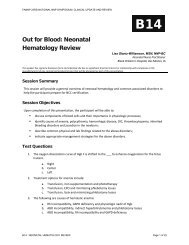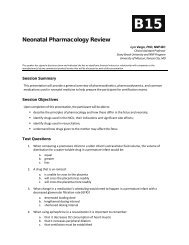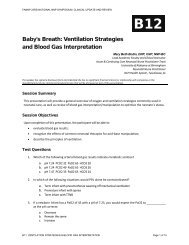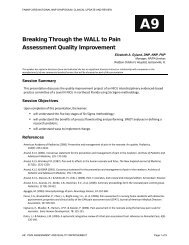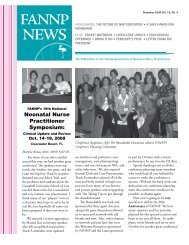Differential Diagnosis and Management of Respiratory ... - FANNP
Differential Diagnosis and Management of Respiratory ... - FANNP
Differential Diagnosis and Management of Respiratory ... - FANNP
Create successful ePaper yourself
Turn your PDF publications into a flip-book with our unique Google optimized e-Paper software.
<strong>FANNP</strong> 23RD NATIONAL NNP SYMPOSIUM: CLINICAL UPDATE AND REVIEW<br />
Objectives:<br />
DDx for <strong>Respiratory</strong> Distress in<br />
the Neonate<br />
Mary Beth Bodin, DNP, CRNP, NNP-BC<br />
•Upon completion <strong>of</strong> this presentation, the participant<br />
will be able to:<br />
•review the differential diagnoses for neonatal<br />
respiratory distress;<br />
•determine appropriate clinical assessments with<br />
radiographic <strong>and</strong> laboratory studies for neonates in<br />
respiratory distress;<br />
•discuss stabilization measures indicated for neonates<br />
in respiratory distress.<br />
<strong>Differential</strong> <strong>Diagnosis</strong><br />
Structural anomalies –non-pulmonary<br />
• Airway obstruction:<br />
• Nasal or pharyngeal: choanal atresia, nasal<br />
edema, blood, meconium, secretions, etc.<br />
• Oral cavity: macroglossia, micronathia, Pierre<br />
Robin Syndrome, teratoma<br />
• Neck: congenital goiter, cystic hygroma,<br />
malposition<br />
• Trachea: tracheomalacia, TEF, tracheal<br />
stenosis, bronchial stenosis<br />
• The nasal passages (choanae)<br />
are separated from the<br />
nasopharynx by a structure<br />
known as the bucconasal<br />
membrane.<br />
• Failure <strong>of</strong> the bucconasal<br />
membrane to normally<br />
perforate during gestation.<br />
• Bilateral in 50% <strong>of</strong> cases.<br />
• Most affected infants are<br />
female.<br />
Choanal Atresia<br />
• Half have associated anomalies<br />
such as CHARGE association.<br />
4<br />
Macroglossia<br />
• Enlargement <strong>of</strong> the tongue which can<br />
be congenital or acquired.<br />
• Most likely secondary to congenital<br />
hemangioma if localized.<br />
• Can be seen with Beckwith’s<br />
syndrome:<br />
• macroglossia, gigantism,<br />
omphalocele <strong>and</strong> severe<br />
hypoglycemia.<br />
• Can be seen with Pompe’s disease:<br />
• glycogen storage disease<br />
• Major feature is micrognathia (small m<strong>and</strong>ible)<br />
• The hypoplasia <strong>of</strong> the m<strong>and</strong>ible.<br />
• Obstructive respiratory distress <strong>and</strong> cyanosis.<br />
• If placing the infant prone does not relieve the<br />
distress, a nasal airway device will be needed.<br />
• Good prognosis for survival if non-syndromic.<br />
Micrognathia:<br />
Pierre Robin Syndrome or<br />
Sequence<br />
5<br />
6<br />
B07: MANAGEMENT OF RESPIRATORY DISTRESS Page 3 <strong>of</strong> 23



